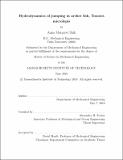| dc.contributor.advisor | Alexandra H. Techet. | en_US |
| dc.contributor.author | Shih, Anna Margaret | en_US |
| dc.contributor.other | Massachusetts Institute of Technology. Dept. of Mechanical Engineering. | en_US |
| dc.date.accessioned | 2011-03-24T18:53:19Z | |
| dc.date.available | 2011-03-24T18:53:19Z | |
| dc.date.copyright | 2010 | en_US |
| dc.date.issued | 2010 | en_US |
| dc.identifier.uri | http://hdl.handle.net/1721.1/61794 | |
| dc.description | Thesis (S.M.)--Massachusetts Institute of Technology, Dept. of Mechanical Engineering, 2010. | en_US |
| dc.description | This electronic version was submitted by the student author. The certified thesis is available in the Institute Archives and Special Collections. | en_US |
| dc.description | Cataloged from student-submitted PDF version of thesis. | en_US |
| dc.description | Includes bibliographical references (p. 113-115). | en_US |
| dc.description.abstract | The maneuvering of fish is not only of interest to those wishing to better understand how fish function, but also is a great inspiration for designing underwater vehicles. This thesis provides the first characterization of the behavior of Toxotes microlepis, the archer fish, as it jumps for bait above the water surface. Two separate studies provide information on both the kinematics and hydrodynamics associated with the jump. The kinematic study makes use of high speed backlight videos and image processing, while the hydrodynamic study relies on high speed digital particle image velocimetry (DPIV). The kinematic study is able to successfully break the jumping behavior into three parts: (1) hovering, (2) thrust production and (3) gliding. Hovering is when the fish is beneath the surface of the water and is trying to maintain position. Thrust production occurs when the archer begins to perform tail strokes and exit the water, resulting in a sharp spike in acceleration and a subsequent increase in velocity. Gliding happens after the archer has partially left the water and is no longer flapping its tail, at which point the archer refrains from any motions until after it has captured its bait. Detailed velocity and acceleration plots are presented. The number of times an archer flaps its tail is shown to increase with the height of the bait, as is the maximum velocity it attains. Additionally, an energy balance is explored. For the hydrodynamic study, PIV shows that each time the archer fish performs a tail stroke during the thrust production phase, a jet is formed that provides impulse to enable jumping. Additionally, the anal fin is shown to have a significant impact on the thrust production, as it also produces a jet. Numerical results for the circulation and impulse created by these jets are presented. | en_US |
| dc.description.statementofresponsibility | by Anna Margaret Shih. | en_US |
| dc.format.extent | 115 p. | en_US |
| dc.language.iso | eng | en_US |
| dc.publisher | Massachusetts Institute of Technology | en_US |
| dc.rights | M.I.T. theses are protected by
copyright. They may be viewed from this source for any purpose, but
reproduction or distribution in any format is prohibited without written
permission. See provided URL for inquiries about permission. | en_US |
| dc.rights.uri | http://dspace.mit.edu/handle/1721.1/7582 | en_US |
| dc.subject | Mechanical Engineering. | en_US |
| dc.title | Hydrodynamics of jumping in archer fish, Toxotes microlepis | en_US |
| dc.title.alternative | Toxotes microlepis | en_US |
| dc.type | Thesis | en_US |
| dc.description.degree | S.M. | en_US |
| dc.contributor.department | Massachusetts Institute of Technology. Department of Mechanical Engineering | |
| dc.identifier.oclc | 707107865 | en_US |

